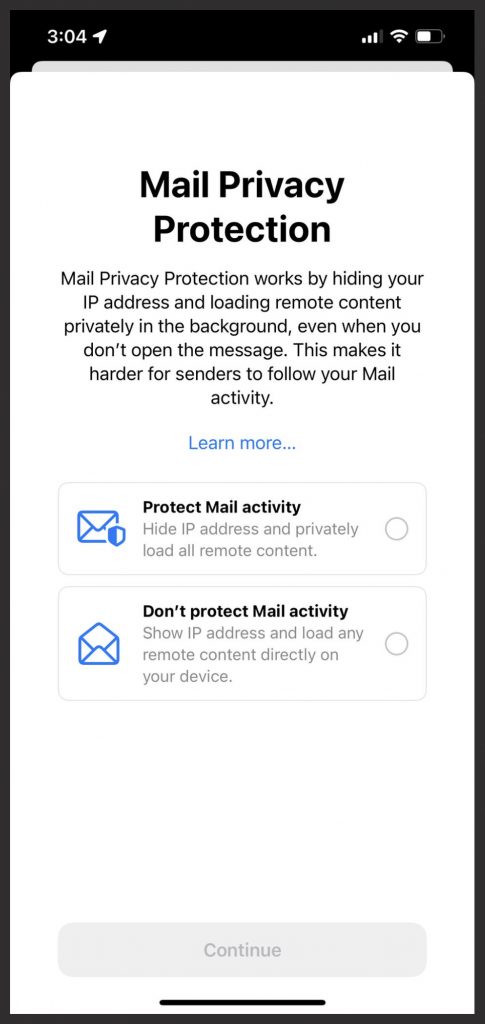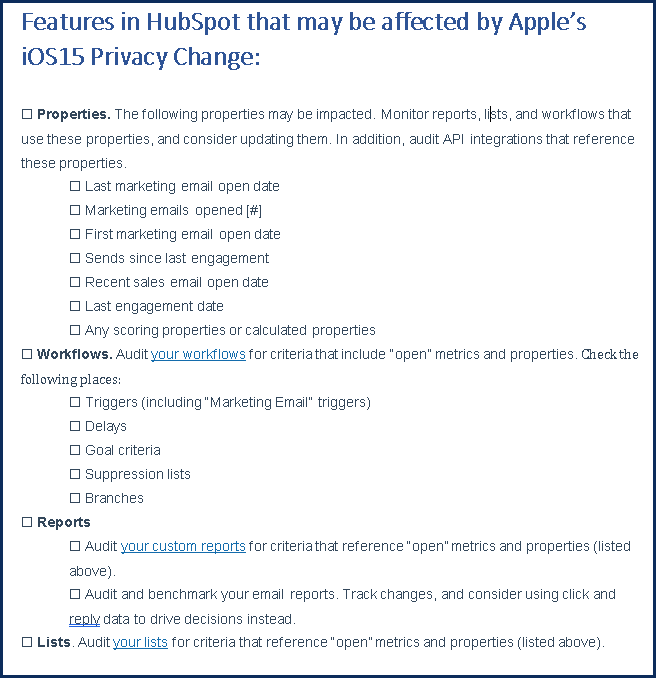In email newsletter marketing, it is common to insert a single image pixel into an email -- to tell whether the email has been opened. Apple's new email privacy policy is interrupting that decades old practice.
Readers can't see the 1-pixel image embedded in their content, but when their email client executes the html code it tells the original server to send the image. The sender, or email service provider, can then record that the image was called, and assume it was likely because the email was opened. The method has been used by marketers worldwide as the best approximation of email open rates.
Recently, Apple launched a new Apple Mail Privacy Protection feature, live on Apple iOS 15, which interrupts and alters the practice of using an image pixel to track opens. Marketers will no longer be able to collect this information about users -- and that's going to have an impact on multiple aspects of email newsletter marketing.
Apple's official notice on the new email privacy features confirms they are intentionally blocking the ability to track opens:
"The new feature helps users prevent senders from knowing when they open an email, and masks their IP address."
The way the privacy option is phrased within iOS, and based on prior opt-in rate for Apple ATT, it is expected that opt-in rates for "privacy" will exceed 90%.
"The new feature helps users prevent senders from knowing when they open an email, and masks their IP address."
- Apple announcement, June 7, 2021
Apple's move follows a number of recent privacy changes such as the Safari Intelligent Tracking Prevention (ITP) code.
7 Ways the Apple Mail Privacy Change Will Impact Email Marketing:
1. Email open rates for Apple Mail users will be unreliable
You'll know how many emails you sent out and how many people clicked on a link with it, but you won't know who actually opened your emails -- and that's a big deal. Apple gives users the choice to have all of the email content downloaded privately by Apple servers, so the open rates may even go up, but it will have no correlation to an iOS user opening emails.
The one-time setting will download all content and tracking pixels in email, without connecting that step to user behavior. If your audience is skewed higher to Apple Mail users, you will likely see over-inflated open rates nearing 100%.
Interested in growing your email newsletter list fast?
Request a demo today of Admiral Visitor Relationship Management (VRM)
2. Impact to campaign automation and segmentation
If you have cohorts, segmentation, triggers, or workflow automation based on the last open date, you may need to re-engineer those processes. It will be difficult to identify users who are truly unengaged with your emails, vs those whose behavior is hidden by Apple's email privacy settings. This can spell trouble for automatic unengaged lists and re-engagement campaigns.
3. Your Android data will differ dramatically from your iOS data
You'll be able to collect more information from Android than iOS, unless Android follows suit. That's important to note because iPhones and Android phones have vastly different demographics. iOS users tend to have higher net worth, for instance, which puts them in a different purchasing demographic.
Marketers will likely compare historical ratios between Apple and Android users, and then use some measure of Android user open rates to approximate or extrapolate the full rate, but it will be much less reliable.
4. You won't be able to track IP addresses for Apple Mail users
The pixel doesn't just report back whether someone opened an email. It also reports back the individual's location and some basic information like their IP address. This can then be used to track their behavior -- such as when they last visited your website, but that connection with email behaviors will now change. Customer journey mapping will be less accurate for Apple Mail users.
The iOS message screenshot makes their objective clear:

5. The loss of data from a significant market, iOS users, will affect A/B split testing
Because you don't have detailed information about your users, you won't be able to complete A/B testing or split testing as well. When you conduct split testing on email newsletter subject lines, preview text, best times and days for opens, you need to be able to determine who is actually opening the email, to determine a winner and loser. Now that will be more challenging, especially for the iOS demographic.
6. You won't have data to give to advertisers or sponsors
Today, if you solicit advertisers or sponsors for your email newsletter, you will usually tell them what your email open rate is. This is one of the primary metrics that businesses use when deciding whether they want to advertise in email newsletters. Without this information, you might not be able to engage as much with other companies.
7. Email marketers will need to rethink list hygiene approaches
Identifying unopens can be just as beneficial to users as opens, so that marketers can avoid spamming users that are not reading their emails. This may be harder to do, and may ultimately be counter-productive for Apple Mail users after the email privacy update.
Blocking email opens deprives senders of a key list health and subscriber engagement metric. It will lead to more unwanted email for subscribers and more deliverability problems for senders, because it makes inactivity management and engagement-based segmentation impossible. https://t.co/TgBEtBq2rk
— Chad S. White (@chadswhite) June 7, 2021
To underscore the impact on marketers, take a look at the list of Hubspot features that may be impacted by Apple's iOS15 change:
What email newsletter publishers should focus on now:
- Quantify your Apple Mail segment. Know what percentage of your email recipients are Apple Mail users, and how much impact they would have on your overall data. For some marketers they might be a fairly small segment of email recipients. Here are three resources that can help identify and segment your Apple mail users:
- Litmus: iOS Analytics Tool - www.litmus.com/blog/email-
analytics-for-mail-privacy- protection/ - EmailOnAcid – www.emailonacid.com/- (similar to Litmus tool)
- SubjectLine.com (Free but different) – On the top right of www.Subjectline.com you will see an iOS 15 calculator to measure an estimated Open Rate
- Litmus: iOS Analytics Tool - www.litmus.com/blog/email-
- Stay tuned in and educated. Register for webinars with top ESP and email vendors to hear strategies that may help.
- Ramp up your testing. Test to get your best handle on creative, what drives opens and engagement. The more data you can gather now to guide campaigns, the better you will be when it's unavailable.
- Review and follow best practices for deliverability, including opt-in permissions, sender reputation score, solid email preference options for opt-outs.
- Find and/or prioritize other data points, such as click-through rate (CTR) over delivered, landing page layouts and conversions, CTA metrics, and other components with a large impact on lower funnel and the bottom line.
- Build deeper relationships with your visitors. Your visitors should never be a one-touchpoint end game. Email newsletters are just one piece of the full visitor relationship. Donations, ads, ad-lite experiences, paid subscriptions, SMS, and push notifications, there are many ways to connect with your visitors, and building your 1st party data will be a hedge against most industry changes.
Litmus: iOS Analytics Tool (Not Free) -www.litmus.com/blog/email-
EmailOnAcid – (Not Free) -www.emailonacid.com/- (similar to Litmus tool)
SubjectLine.com (Free but different) – On the top right of www.Subjectline.com you will see an iOS 15 calculator. After the world falls apart you can use this simple calculator to measure your estimated ‘Open Rate’
Want to grow your email newsletter list FAST, or add GDPR consent management?
Admiral's email growth solution is easy to install and manage, with branded CTA that will add email subscribers immediately. Building your authenticated user segment has multiple benefits, and studies show a 3-4X improvement in conversions for paid subscriptions.
Admiral, The Visitor Relationship Management Company, offers email growth, adblock recovery, paid subscriptions, paywalls and registration walls, privacy consent management for GDPR/CCPA, donations campaigns, social follower growth, and more.
Request a demo today.






